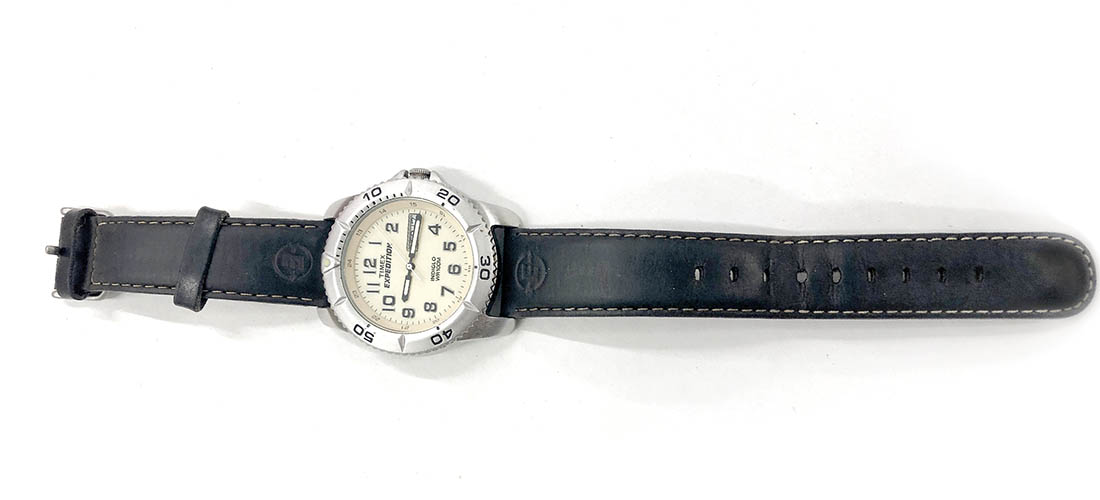Just a Cup
A memoir served with hot coffee
By Martin Brown
I spent spring break of my final year of college in the wreckage of my late grandparents’ home. I was digging through decades of garbage in order to save the memories that lay amid the refuse; I spent hours on my knees sorting through broken dishware; I pulled old glasses out of piles of filth and animal eggs; I became sick from breathing dirty air; and I would do it all again. As I’m writing this, I’m drinking out of a coffee cup which is more than twice my age, and if you give me a moment, I’ll tell you why.
When VE day happened and World War II was coming to an end, James “Leroy” Brown was lying in a field hospital with his head containing several, newly added, pieces of shrapnel. His helmet had been punctured by fast-moving bomb shards, some of which lodged in his head (he was a quiet fella, but God help anyone who called him empty-headed from there on out). He had a few small pieces of metal added to his head and, for his trouble, he’d soon have another piece pinned to his chest.
The shrapnel failed to do any serious damage, and Leroy was on the verge of being sent back to the front when he got news that fighting was going to stop. Now, I can’t tell you what was said in those moments. I can’t tell you what went through the head of the man whose head was making a nasty habit of having things go through it, but I can tell you one thing: He didn’t want to forget.
He wanted to remember those days and all they meant. This is evidenced by the fact that he kept that helmet after his friends snuck into the garbage and saved the thing that saved their buddy. Ruined beyond hope of use, that helmet was thrown out twice, and twice it was saved.
Today, it sits on a stand looking down from my father’s bookcase, watching as the child of its former owner, who wouldn’t have been born without that helmet, does his work, or scrolls on his phone, or falls asleep at the computer. An old helmet gathering dust, but also, maybe, still protecting something.
We entered the drooping little house wearing surgical gloves and masks. The air was heavy with dust and decay. In spite of our precautions, I ended up violently ill following the trip. The house had been standing since just after the war, when my grandfather came home with nothing but a head full of metal and the promise of work at a nearby textile mill.
He got that job at the mill. He walked into that building every workday for 50 years. But less than one year into those 50 he found he had something else: a brother with a girlfriend, and the girlfriend had a cousin (a little spitfire named Mary Alice Poole), and the brother and the girlfriend thought they’d get on fine.
Then, two years into the 50, they built the ranch house at the bottom of the hill, Leroy and that little spitfire, who was now his wife. And in 2019, three grandchildren and two sons walked into what used to be that pretty little house, where several decades of history sat mingling under dust and debris.
The house was devastated, and overgrown. It had been only three years since my grandmother passed, but it had already been in bad shape, and an empty house can’t stand. In the back room, which once housed my infant father, a piece of ceiling had caved in, leaving a hole that led out onto the roof. This hole had become a port of entry for raccoons and other animals seeking to reclaim the little patch of land, and whatever else they could get hold of. We brought in garbage bags for the things that were undesirable or ruined, and plastic bins for the memories.
Leroy Brown never met a cup of coffee too dark. As I walked in with my travel mug — the Leroy special: Coffee. Black. Nothing fancy — I noticed some of my grandmother’s tins of loose-leaf tea. They made me think of the ones I had at home and of Chinese tea ceremonies. Of traditional clay pots being used to make the same tea day in and day out until the clay soaks in so much flavor that, provided hot water, it will produce tea, even without leaves in the pot.
Walking around in that house felt like standing in a teapot that had been filled time and again with love and laughter but which now sat empty. We were there to drink it in one last time. To see what flavor remained.
We found stacks of National Geographic magazines going back decades, forming a more complete collection than most libraries. We found a map of Disney World from the 1970s when the park was new. We found childish drawings, college-bound notebooks, and wedding china.
As we dug through the contents of the house, we held up things for each other to see: a silent question. We deferred to the memories of my father and uncle, who would lean back, wipe a brow and reminisce in response to the call of, “Is this important?” We each made piles of things we claimed, and the rest was split simply into garbage and not.
Being the youngest there, I tried to do my share of the lifting and crawling around. I stumbled across countless forgotten things no longer serving whatever purpose they originally had. One such item was a small bit of metal which looked not unlike a handheld stapler; what it actually was I had no idea. In the moment, I saved it only because it looked unique, and I’m glad I did.
It’s sitting on my desk now. The device is made up of a lever which, when squeezed, applies pressure to a couple of round plates a little larger than a silver dollar. I’m holding it now as I held it then. On the day I found it, after being told what it might be, I asked the others for a scrap of paper and, when finally we managed to find one, I slid it into the mouth of the little thing. As I squeezed, I could hear the paper whine as it stretched and wrinkled. Then I pulled it out and looked.
“MARY ALICE BROWN – NOTARY PUBLIC – SOUTH CAROLINA”
The seal formed a circle. In the center in larger print was the title, while my grandmother’s name and the name of her state encircled it as a border. It reminded me of something that would be coated in gold in the bottom corner of a diploma.
Looking at that seal was as good as seeing my grandmother, young and beautiful, behind her desk, surrounded by the stacks of paper that she combed through dutifully. The little device is sturdy, reliable and capable in spite of the years. In it I see the woman whose name it bears.
I don’t recall ever hearing Mary Alice Poole Brown ask for help, and I certainly don’t recall seeing her fail. Whether it was at the offices where she worked, in spite of massive workloads and the occasional “coffee girl” joke; the church where she served as a clerk; or in her personal life, Mary Alice Brown was the sort to do the job till it was done and to smile when she handed it in.
My grandparents lived through difficult times and, like many who went through the same, they developed difficulty in letting things go. The precious memories mixed with the everyday, and slowly the little house gained a not-so-little load.
We found stacks of paper cups that had been rinsed and saved, food containers reused and long-spoiled, and broken knick-knacks that “someone may still want.” It was difficult at times to decide what should stay and what should go.
In case you don’t quite see the problem, I present to you a stack of papers, tattered and yellow. Garbage or not? They clearly were once a book, and beside them under the remains of my uncle’s childhood bed, lies the faded cover, which faintly reads: Alice’s Adventures in Wonderland & Through the Looking Glass, by Lewis Carroll.
Mary Alice was a voracious reader. The way Leroy could devour pots of black coffee, so would she devour books. So, no granddaughter of hers was going to grow up without learning to love reading. When her eldest grandchild (my cousin) came to play, she would call her over and pull her onto her lap as she pulled out some book filled with mystery and wonder.
If you try, I’m sure you can see it. The girl in her grandmother’s lap marveling at the old book’s silly words and talking animals. If you really try, you can see further, to a bookish little spitfire of a girl on Christmas morning with a book, bright and new, still with the smell of fresh pages. Two little girls learning to love reading from the same slow-tattering pages.
Sit there a moment with that book. Watch Mary Alice sipping some tea and taking a break from her own Agatha Christie to gain a potential future addition to her book club.
I handed the pages to my cousin, without knowing what they meant, the pages with the inscription “Mary Alice Poole, December 25, 1936.” Mary Alice’s trick had worked. I’ve known few people who love words as fiercely as my cousin. Today she is an editor, and her husband a writer. The book was little more than mildewy pages, as removed from that moment 30 years ago, as my cousin likely felt. She stood a moment, transfixed, and I suggested that she could find some of the more preserved pages and frame them under a photo of our grandmother. She was flipping through the old leaves without really looking at them when I saw tears fall. She left the room and none of us followed. We had garbage bags to fill.
I promised you at the beginning of all this that I would explain why I drink out of an old cup. When I write, it’s my grandfather’s old Army green coffee cup, the short, bowl-shaped one from the set they bought when they first took to living in that little ranch house. When I edit, it’s my grandmother’s souvenir mug from Myrtle Beach or the one that reads “Best secretary. Not a coffee girl.”
When I hold the mug that held my grandmother’s tea during reading time, or that she took her coffee in before work — when I feel the warmth of the drink seeping into my fingers — I soak up more than heat. But it isn’t from the cup.
When a man looks up from his desk at his father’s helmet, or a woman stands holding some old papers that used to be a book, maybe that feeling in their chest isn’t coming from the thing. Maybe a relic is just a relic. As I stand here holding Mary Alice’s mug, there is a piece of her here. But it isn’t in the mug. It’s in me.
Martin Brown was born in Winston-Salem and received a degree in writing from UNCW. A writer of narrative nonfiction, he collects coffee mugs.


